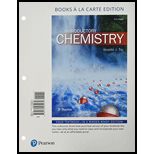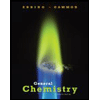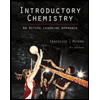
Introductory Chemistry, Books a la Carte Plus Mastering Chemistry with Pearson eText -- Access Card Package (6th Edition)
6th Edition
ISBN: 9780134557311
Author: Nivaldo J. Tro
Publisher: PEARSON
expand_more
expand_more
format_list_bulleted
Textbook Question
Chapter 3, Problem 81E
An iron nail with a mass of 12 g absorbs 15 J of heat. If the nail was initially at 28°C, what is its final temperature?
Expert Solution & Answer
Want to see the full answer?
Check out a sample textbook solution
Students have asked these similar questions
The two equations are forms of the Davies equation, used in thermodynamics for
activity coefficients:
ال
log Y₁ = -Az²
- 0,31
log
= Az²
- 0,31
1 + √Ĩ
1 + √√
k
These equations are consistent and imply that
Yi
=
Is this last equation correct?
k
For the Davies equation, both expressions are correct:
log Y₁ = -Az²
√i
- 0,31
1 +
√
k
log-
= Az
- 0,31
k
1 + √Ĩ
k
In Davies' equation log y₁ = log-
log y₁ = log | = -Az² + ✓//
k
A is a constant that always equals 1.02. Correct?
- 0,31
Chapter 3 Solutions
Introductory Chemistry, Books a la Carte Plus Mastering Chemistry with Pearson eText -- Access Card Package (6th Edition)
Ch. 3 - Which substance is a pure compound? a. Gold b....Ch. 3 - Which property of trinitrotoluene (TNT) is most...Ch. 3 - Which change is a chemical change? a. The...Ch. 3 - Q4. Which process is endothermic?
a. The burning...Ch. 3 - Q5. A 35-g sample of potassium completely reacts...Ch. 3 - Prob. 6SAQCh. 3 - Convert the boiling point of water (100.00C) to K....Ch. 3 - Q8. A European doctor reports that you have fever...Ch. 3 - Q9. How much heat must be absorbed by 125 g of...Ch. 3 - Q10. Substance A has a heat capacity that is much...
Ch. 3 - Define matter and list some examples.Ch. 3 - Prob. 2ECh. 3 - What are the three states of matter?Ch. 3 - Prob. 4ECh. 3 - Prob. 5ECh. 3 - Prob. 6ECh. 3 - Prob. 7ECh. 3 - Prob. 8ECh. 3 - 9. What is a mixture?
Ch. 3 - 10. What is the difference between a homogeneous...Ch. 3 - What is a pure substance?Ch. 3 - What is an element? A compound?Ch. 3 - What is the difference between a mixture and a...Ch. 3 - Prob. 14ECh. 3 - 15. What is the difference between a physical...Ch. 3 - Prob. 16ECh. 3 - Prob. 17ECh. 3 - Prob. 18ECh. 3 - Prob. 19ECh. 3 - What is chemical energy? List some examples of...Ch. 3 - Prob. 21ECh. 3 - 22. What is an exothermic reaction? Which has...Ch. 3 - 23. What is an endothermic reaction? Which has...Ch. 3 - Prob. 24ECh. 3 - Prob. 25ECh. 3 - 26. How do the three temperature scales differ?
Ch. 3 - Prob. 27ECh. 3 - Prob. 28ECh. 3 - The following equation can be used to convert...Ch. 3 - Prob. 30ECh. 3 - Classify each pure substance as an element or a...Ch. 3 - 32. Classify each pure substance as an element or...Ch. 3 - 33. Classify each mixture as homogeneous or...Ch. 3 - 34. Classify each mixture as homogeneous or...Ch. 3 - 35. Classify each substance as a pure substance or...Ch. 3 - 36. Classify each substance as a pure substance or...Ch. 3 - Classify each property as physical or chemical. a....Ch. 3 - Classify each property as physical or chemical. a....Ch. 3 - Which of the following properties of ethylene(a...Ch. 3 - Which of the following properties of ozone (a...Ch. 3 - 41. Classify each change as physical or...Ch. 3 - 42. Classify each change as physical or...Ch. 3 - A block of aluminum is (a) ground into aluminum...Ch. 3 - 44. Several pieces of graphite from a mechanical...Ch. 3 - 45. An automobile gasoline tank holds 42 kg of...Ch. 3 - In the explosion of a hydrogen-filled balloon,...Ch. 3 - 47. Are these data sets on chemical changes...Ch. 3 - 48. Are these data sets on chemical changes...Ch. 3 - Prob. 49ECh. 3 - 50. A 56-g sample of iron reacts with 24 g of...Ch. 3 - Prob. 51ECh. 3 - Prob. 52ECh. 3 - Prob. 53ECh. 3 - Prob. 54ECh. 3 - Prob. 55ECh. 3 - Prob. 56ECh. 3 - Prob. 57ECh. 3 - Prob. 58ECh. 3 - Prob. 59ECh. 3 - Prob. 60ECh. 3 - 61 A common type of handwarmer contains Iron...Ch. 3 - 62. In a chemical cold pack, two substances are...Ch. 3 - 63. Classify each process as exothermic or...Ch. 3 - Classify each process as exothermic or...Ch. 3 - Perform each temperature conversion. a.212 F to...Ch. 3 - Prob. 66ECh. 3 - The coldest temperature ever measured in the...Ch. 3 - 68. The warmest temperature ever measured in the...Ch. 3 - 69. Vodka does not freeze in the freezer because...Ch. 3 - Liquid helium boils at 4.2 K. Convert this...Ch. 3 - 71. The temperature in the South Pole during the...Ch. 3 - Prob. 72ECh. 3 - Prob. 73ECh. 3 - Prob. 74ECh. 3 - 75. Calculate the amount of heat required to raise...Ch. 3 - 76. Calculate the amount of heat required to raise...Ch. 3 - Calculate the amount of heat required to heat a...Ch. 3 - 78. Calculate the amount of heat required to heat...Ch. 3 - If 89 J of heat are added to a pure gold coin with...Ch. 3 - If 57 J heat are added to an aluminum can with a...Ch. 3 - An iron nail with a mass of 12 g absorbs 15 J of...Ch. 3 - Prob. 82ECh. 3 - Prob. 83ECh. 3 - 84. A lead fishing weight with a mass of 57 g...Ch. 3 - An unknown metal with a mass of 28 g absorbs 58 J...Ch. 3 - When 2.8 J of heat are added to 5.6 g of an...Ch. 3 - When 56 J of heat are added to 11 g of a liquid,...Ch. 3 - Prob. 88ECh. 3 - Prob. 89ECh. 3 - Prob. 90ECh. 3 - How much energy (In J) lost when a sample of iron...Ch. 3 - Prob. 92ECh. 3 - Prob. 93ECh. 3 - Prob. 94ECh. 3 - A pure gold ring with a volume of 1.57 cm3 is...Ch. 3 - Prob. 96ECh. 3 - Prob. 97ECh. 3 - Prob. 98ECh. 3 - 99. What is the temperature change (ΔT) in Celsius...Ch. 3 - Prob. 100ECh. 3 - Prob. 101ECh. 3 - Prob. 102ECh. 3 - A backpacker wants to carry enough fuel to heat...Ch. 3 - 104. A cook wants to heat 1.35 kg of water from...Ch. 3 - Evaporating sweat cools the body because...Ch. 3 - Prob. 106ECh. 3 - A 15.7-g aluminum block is warmed to 53.2C and...Ch. 3 - A 25.0-mL sample of ethanol (density = 0.789g/mL)...Ch. 3 - The wattage of an appliance indicates its average...Ch. 3 - Prob. 110ECh. 3 - What temperature is the same whether it is...Ch. 3 - What temperature on the Celsius scale is equal to...Ch. 3 - 113. Classify each as pure substance or a...Ch. 3 - Classify each as a pure substance or a mixture. If...Ch. 3 - This molecular drawing shows images of acetone...Ch. 3 - This molecular drawing shows of methane molecules...Ch. 3 - Prob. 117ECh. 3 - Global warming refers to the rise in average...Ch. 3 - 119. Examine the data for the maximum and minimum...Ch. 3 - Using white and black circles to represent...Ch. 3 - Prob. 121QGWCh. 3 - 122. A friend asks you to invest in a new...Ch. 3 - Prob. 123QGW
Knowledge Booster
Learn more about
Need a deep-dive on the concept behind this application? Look no further. Learn more about this topic, chemistry and related others by exploring similar questions and additional content below.Similar questions
- Indicate whether the equality is true Yi How is it obtained? k%arrow_forwardIndicate the relationship between the activity coefficient YA and the rate constant of a bimolecular reaction in solution k and the rate constant at infinite dilution ko.arrow_forwardDescribe the saline effect that occurs in solutions.arrow_forward
- Briefly explain what the infinite dilution rate constant (k∞) consists of.arrow_forwardThe Davies equation corrects the Debye-Hückel limiting law for calculating the activity coefficient of an electrolyte in solution at relatively high concentrations. Mathematically, it is expressed as: log y₁ = -Az²? 1 + √Ĩ - 0,31) Is the formula correct?arrow_forwardDifferentiate between the concepts of "ionic salt effect" and "kinetic salt effect."arrow_forward
- Differentiate the concepts of “salino effect” and “salino kinetic effect”.arrow_forwardCome and compare the Bronsted-Bjerrum calculation, the Debye and Hückel calculation, and the Davies calculation.arrow_forwardplz watch the youtube video (the title of this topic) by roxi H. she explains it step by step but i get the wrong answerarrow_forward
- Writing the rate law implied by a simple mechanism To exit full screen, press and hold esc Suppose the decomposition of ozone proceeds by the following mechanism: step elementary reaction rate constant 1 →>> O3(9) O2(g) + O(g) k₁ 2 03(g) + O(g) → 202(g) k2 Suppose also k₁ »k2. That is, the first step is much faster than the second. Write the balanced chemical equation for the overall chemical reaction: Write the experimentally- observable rate law for the overall chemical reaction. ☐ rate = ☐ Note: your answer should not contain the concentrations of any intermediates. Express the rate constant k for the overall chemical reaction in terms of K1, K2, and (if necessary) the rate constants k-1 and K-2 for the reverse of the two elementary reactions in the mechanism. k = ☐ 000 18 ローロ Ar OOarrow_forwardDeducing a rate law from the change in concentration over time To exit full screen, press and hold esc A chemistry graduate student is studying the rate of this reaction: H2CO3(aq) → H₂O(aq) +CO₂ (aq) - She fills a reaction vessel with H2CO3 and measures its concentration as the reaction proceeds: time (milliseconds) [H2CO3] 0 0.0500 M 10. 0.0266M 20. 0.0181 M 30. 0.0138M 40. 0.0111 M Use this data to answer the following questions. Write the rate law for this reaction. Calculate the value of the rate constant k. Round your answer to 2 significant digits. Also be sure your answer has the correct unit symbol. rate ☐ x10 k = Х 000 18 Ararrow_forwardWriting the rate law implied by a simple mechanism Suppose the formation of tert-butanol proceeds by the following mechanism: step elementary reaction 1 (CH3)3 CBr(aq) → (CH3)2 C* (aq) + Br (aq) 2 (CH3)2C (aq) + OH¯ (aq) → (CH3)2COH(aq) rate constant k₁ k₂ Suppose also k₁ »k2. That is, the first step is much faster than the second. Write the balanced chemical equation for the overall chemical reaction: Write the experimentally- observable rate law for the overall chemical reaction. Note: your answer should not contain the concentrations of any intermediates. rate = k ☐ Express the rate constant k for the overall chemical reaction in terms of K1, K2, and (if necessary) the rate constants k-1 and K-2 for the reverse of the two elementary reactions in the mechanism. k = ☐ □ ☑ G ? 00. 18 Ar Barrow_forward
arrow_back_ios
SEE MORE QUESTIONS
arrow_forward_ios
Recommended textbooks for you
- Chemistry: Matter and ChangeChemistryISBN:9780078746376Author:Dinah Zike, Laurel Dingrando, Nicholas Hainen, Cheryl WistromPublisher:Glencoe/McGraw-Hill School Pub Co
 General Chemistry - Standalone book (MindTap Cour...ChemistryISBN:9781305580343Author:Steven D. Gammon, Ebbing, Darrell Ebbing, Steven D., Darrell; Gammon, Darrell Ebbing; Steven D. Gammon, Darrell D.; Gammon, Ebbing; Steven D. Gammon; DarrellPublisher:Cengage Learning
General Chemistry - Standalone book (MindTap Cour...ChemistryISBN:9781305580343Author:Steven D. Gammon, Ebbing, Darrell Ebbing, Steven D., Darrell; Gammon, Darrell Ebbing; Steven D. Gammon, Darrell D.; Gammon, Ebbing; Steven D. Gammon; DarrellPublisher:Cengage Learning Chemistry: Principles and ReactionsChemistryISBN:9781305079373Author:William L. Masterton, Cecile N. HurleyPublisher:Cengage Learning
Chemistry: Principles and ReactionsChemistryISBN:9781305079373Author:William L. Masterton, Cecile N. HurleyPublisher:Cengage Learning  Chemistry by OpenStax (2015-05-04)ChemistryISBN:9781938168390Author:Klaus Theopold, Richard H Langley, Paul Flowers, William R. Robinson, Mark BlaserPublisher:OpenStax
Chemistry by OpenStax (2015-05-04)ChemistryISBN:9781938168390Author:Klaus Theopold, Richard H Langley, Paul Flowers, William R. Robinson, Mark BlaserPublisher:OpenStax Living By Chemistry: First Edition TextbookChemistryISBN:9781559539418Author:Angelica StacyPublisher:MAC HIGHER
Living By Chemistry: First Edition TextbookChemistryISBN:9781559539418Author:Angelica StacyPublisher:MAC HIGHER Introductory Chemistry: An Active Learning Approa...ChemistryISBN:9781305079250Author:Mark S. Cracolice, Ed PetersPublisher:Cengage Learning
Introductory Chemistry: An Active Learning Approa...ChemistryISBN:9781305079250Author:Mark S. Cracolice, Ed PetersPublisher:Cengage Learning

Chemistry: Matter and Change
Chemistry
ISBN:9780078746376
Author:Dinah Zike, Laurel Dingrando, Nicholas Hainen, Cheryl Wistrom
Publisher:Glencoe/McGraw-Hill School Pub Co

General Chemistry - Standalone book (MindTap Cour...
Chemistry
ISBN:9781305580343
Author:Steven D. Gammon, Ebbing, Darrell Ebbing, Steven D., Darrell; Gammon, Darrell Ebbing; Steven D. Gammon, Darrell D.; Gammon, Ebbing; Steven D. Gammon; Darrell
Publisher:Cengage Learning

Chemistry: Principles and Reactions
Chemistry
ISBN:9781305079373
Author:William L. Masterton, Cecile N. Hurley
Publisher:Cengage Learning

Chemistry by OpenStax (2015-05-04)
Chemistry
ISBN:9781938168390
Author:Klaus Theopold, Richard H Langley, Paul Flowers, William R. Robinson, Mark Blaser
Publisher:OpenStax

Living By Chemistry: First Edition Textbook
Chemistry
ISBN:9781559539418
Author:Angelica Stacy
Publisher:MAC HIGHER

Introductory Chemistry: An Active Learning Approa...
Chemistry
ISBN:9781305079250
Author:Mark S. Cracolice, Ed Peters
Publisher:Cengage Learning
The Laws of Thermodynamics, Entropy, and Gibbs Free Energy; Author: Professor Dave Explains;https://www.youtube.com/watch?v=8N1BxHgsoOw;License: Standard YouTube License, CC-BY